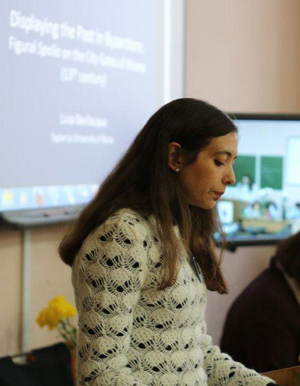Livia Bevilacqua
Sapienza University, Rome, Italy
Supervising professor: Prof. Antonio Iacobini
Displaying the Past in Byzantium. Figural “Spolia” on the City Gates of Nicaea (13th Century) 
Recovering and reusing ancient ‘spolia’ has been a common practice throughout the Middle Ages, in the European West as well as in the Byzantine East. Their decoration was usually geometrical, ornamental or symbolic, but also figurative. Although several cases are known of figural ‘spolia’, their meaning has seldom been studied in context. Focusing on the ‘new’ context in which they were reused, it is possible to find out that a number of ancient or Byzantine pieces depicting narrative scenes or human figures might have been chosen intentionally. Their rearrangement (on precious objects, in architecture or in the public urban space) has often brought about, on the one hand, either a misunderstanding or a conscious change in their significance and function. On the other hand, some of those ‘spolia’ could be reemployed with a conscious revival of their original meaning. It is thus intriguing to understand why this happened, and how the beholder would react to them.
In Anatolia in the Byzantine era, a number of cases are attested in which figural ‘spolia’ (i.e. pieces of ancient sculpture, stone carvings or reliefs) were reused in the building or restoration of city walls and fortresses. Especially striking is the display of such ‘spolia’ as part of the decoration of the main gates.
In this paper, I will focus on this peculiar aspect, and particularly on the gates of the outer wall of the city of Nicaea (today Iznik), built during the reign of emperor John III Vatatzes (1222–1254), a member of the ruling Lascarid dynasty. This case is particularly interesting, in so far as it is one of the richest examples surviving, in terms of the variety and size of the materials displayed, which must have created the strongest visual impact, in the time when Nicaea was regarded as the ‘temporary capital’ of the Byzantine empire. A comparison will be carried out between the surviving works and the testimony of the written sources, both Byzantine and Western.


